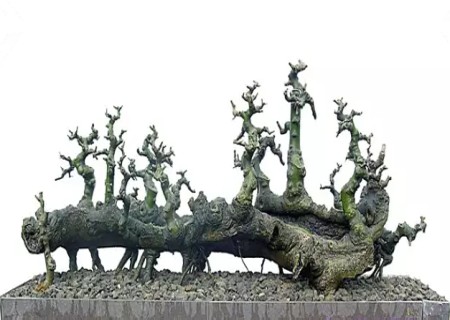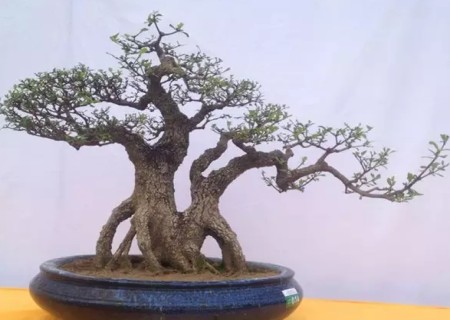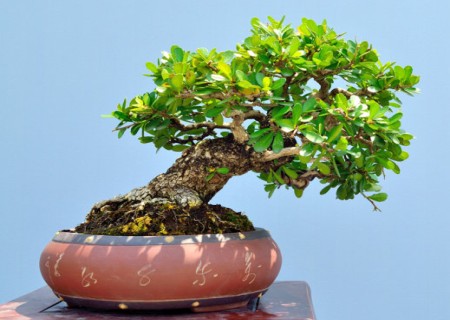Truncation and Branch accumulation and Branch trend treatment of Lingnan Bonsai
The creation of Lingnan bonsai has always paid attention to the trend of branches, whether to create a perfect Lingnan bonsai works, mainly depends on whether the trunk is in place, which is well known. The trend of the branches of bonsai plants is directly related to the layout of the whole work and the complementary effect.

Truncation is a relative concept, which is not to cut off the trunk of the plant, but also to cut off the branches that affect the appearance of the trunk. Through repeated truncation treatment, the purpose of storing branches can be achieved, of course, it also needs to be decided from the overall layout of the branches.
If not through truncation treatment, let those branches grow wantonly, and focus on stretching, flat binding for modeling, the branches will soon appear aging phenomenon, or even off foot. And through stretching, flat binding will hurt the subcutaneous bud position, and even cause serious consequences for some tree species that will never sprout.
In addition, in order to do a good job in the layout of Lingnan bonsai, the trend of the branches is particularly important, especially the starting point of the branch receptacle and the angle of the germinating branches must be grasped. The branches used for bonsai modeling usually require more than 45 °angle. this needs to be dealt with in the way of parallel angle, that is, the unaged branches will be bent with iron wire by means of manual intervention.
Of course, we also need to grasp the context of the branches in the modeling process, that is, the main branches and side branches. In particular, the main branches need to achieve the effect of ups and downs, with a very strong sense of rhythm, while the lateral branches are mostly in the form of line-like softness.
The excellent modeling effect is inseparable from the creation of key branches and key branches, which is mostly accomplished by the combination of floating branches, exploring branches, dragging branches, falling branches, purging branches and so on. Here, the editor gives you a brief introduction to these concepts:
1. Floating branches, that is, the main branches float slightly downward in parallel, in order to make the branches look more perfect and have a sense of rhythm.
2. Exploring branches, which is similar to floating branches, but its biggest feature is that it can stand out from the crowd and set up a school of its own among many modeling branches.
3. Dragging branches, mostly used for oblique dry bonsai modeling, with the effect of pressing the foot after breaking.
4. The falling branch, that is, the strong effect of sudden collapse in the extension of the main branch, is often reflected in the towering tree shape.
5. Xiezhi, as its name implies, means that when the main branch grows, it immediately bends downward to show a state of flow, giving people an imposing effect.
In short, in the modeling of Lingnan bonsai, in order to show it with the most beautiful posture, we must pay attention to the direction of the branches. If the trend of the branches is handled well, everyone will be happy; otherwise, the sadness of the creation will turn into regret.
Time: 2019-06-04 Click:
- Prev

The trend of branches of Lingnan bonsai
Lingnan bonsai has always paid attention to branch support ability and its trend, whether it is good enough or not depends on whether your branch support can be cut off and store branches, which is certain and beyond reproach. The trend of the branch support is directly related to the layout and inherits from each other. Truncation is relatively speaking, either truncation or truncation
- Next

The method of topping branches of Lingnan bonsai
For the knot of the stump bonsai, the traditional left and right way can be changed into a spiral knot, which can keep the crown low without losing the rich tree shape, and the wonderful effect of bonsai plants from stout and low trunks in a specific natural environment. At the same time, it also gives people a refreshing, simple and natural feeling.
Related
- Fuxing push coffee new agricultural production and marketing class: lack of small-scale processing plants
- Jujube rice field leisure farm deep ploughing Yilan for five years to create a space for organic food and play
- Nongyu Farm-A trial of organic papaya for brave women with advanced technology
- Four points for attention in the prevention and control of diseases and insect pests of edible fungi
- How to add nutrient solution to Edible Fungi
- Is there any good way to control edible fungus mites?
- Open Inoculation Technology of Edible Fungi
- Is there any clever way to use fertilizer for edible fungus in winter?
- What agents are used to kill the pathogens of edible fungi in the mushroom shed?
- Rapid drying of Edible Fungi

